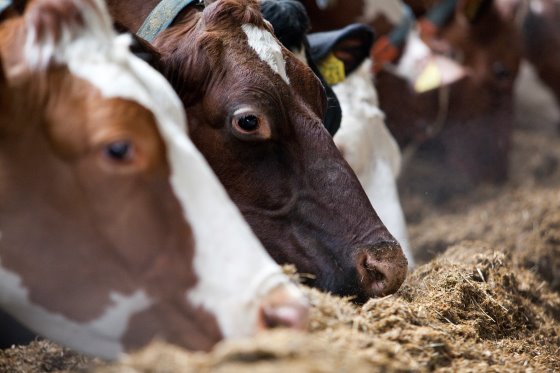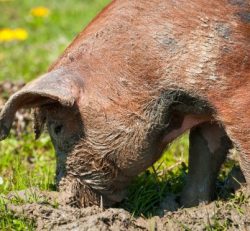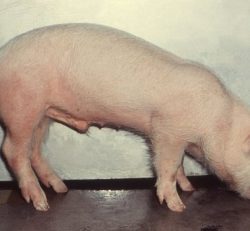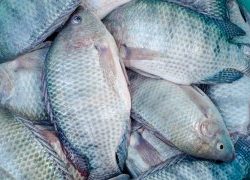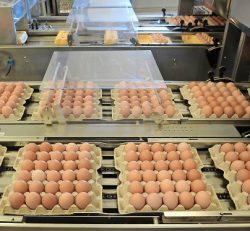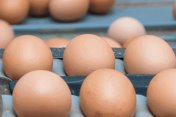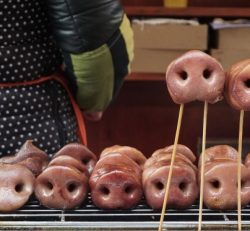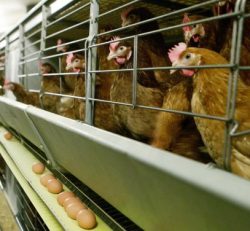RUMEN AT THE HEART OF FEED EFFICIENCY
The rumen is actually the keystone of feed efficiency: it is the main first organ of the cow digestive tract. What can be done to further optimise it?
Feed efficiency can be defined as the ratio between performance and feed consumption. In dairy farming, performance can be expressed by Energy Corrected Milk (ECM), which takes into account milk yield, but also protein and fat contents. Feed consumption is commonly expressed in kilograms of Dry Matter Intake (DMI). Production on feed intake is continuously measured in beef cattle, poultry or swine production to control economic performance.
Feed efficiency is poorly used
Whereas it has great influence on farmers’ income, feed efficiency is poorly used either by the farmers or by the dairy industry in general. Several studies measured feed efficiency across dairy herds, and demonstrated important variation: from 1.1 to 1.9 kg ECM/kg DM. In terms of revenue, this difference represents $ 5.00/cow/day (from Cabrera, 2009), assuming a milk price of $ 0.26/kg and a diet cost of $ 0.22/kg DM). Feed efficiency monitoring has become more and more important to secure farm income. Indeed, milk prices are still volatile in different markets and tend to decrease, whereas raw materials prices globally increase.
What can explain variation in feed efficiency?
Important variation in feed efficiency can be measured among animals and numerous possible causes have been identified. This includes days in milk, body weight change, activity, etc. However, main factors are linked to feed it-self: diet composition, raw materials digestibility – especially forages – as well as distribution, palatability or rumen passage rate.
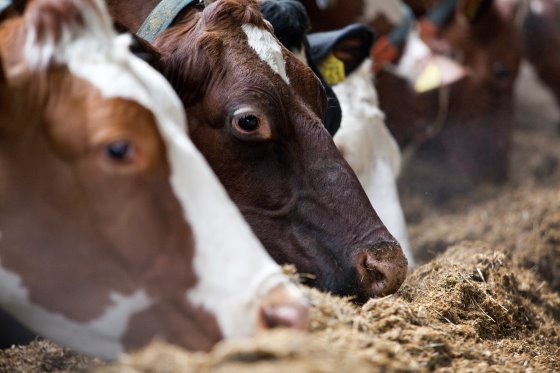
Dairy farmers have historically fed diets with a protein level beyond cow requirements, notably to counteract a naturally poor use of proteins by the cows. Photo: Jan Willem Schouten
Rumen is actually the keystone of feed efficiency: it is the main first organ of the cow digestive tract. This large vault harbours a wide microflora population responsible for nutrients digestion and distribution to the host organs and tissue. Rumen, in association with the reticulum, is indeed a very effective fermenter that breakdown diet constituents: starch, cellulose, protein and, to a lesser extent, fat. Among the multiple processes happening in the rumen, 2 main outcomes are expected from rumen functioning:
- Volatile Fatty Acids (VFA)
- Metabolisable Protein (MP).
Improving feed efficiency, from rumen perspective, means a maximal availability of these 2 nutrients in the intestinal tract.
Effect of feeding practices
Dairy farmers have historically fed diets with a protein level beyond cow requirements, notably to counteract a naturally poor use of proteins by the cows. Indeed, research has demonstrated that usually less than 30% of protein intake can be retrieved in milk protein content form. Such practice can also be advised by nutritionists in order to provide sufficient essential amino acids supply for absorption in the gut. However, rumen capture and degradation of proteins as well as microbial synthesis variation can randomly change the amount and profile of MP supplied to the gut, which cannot be easily controlled in farming conditions.
Up to 80% of energy supply to ruminants comes from VFA. Rumen fermentations produce mainly acetic, butyric, lactic and propionic acids. Levels and ratio of each VFA for optimum rumen efficiency have been determined after years of research and constitute nutrition standards. Due to a high level of concentrates in modern dairy farming, rumen functioning can be disturbed and this can lead to misbalanced ratios of VFA. An increase of concentrates intake has been shown to increase acetic and lactic acids production and to decrease ruminal pH. In the short term this strategy can in fact lead to more VFA production from important and rapid starch degradation of concentrates. But constant drops in ruminal pH cause non-ideal condition for cellulolytic flora development. This leads to the decrease of fibre digestibility, whereas it accounts for a consequent amount of ruminants’ diets.
Both protein and energy efficiency are important and furthermore, correlated. Indeed, microbial synthesis of protein is energy dependent, and recent research has shown that “synchronising” the timing of energy supply with protein degradation may maximise protein synthesis and minimise nitrogen waste into ammonia.
Which strategies to increase feed efficiency?
Starting with fundamentals, feedstuffs should be chosen for their digestibility and nutrient bioavailability. Such parameters can be monitored with indicators such as:
- Total Digestible Nutrients (% of Dry Matter),
- Digestible Energy (Mcal/kg),
- Protein Digestion rate (%/h) or
- Metabolizable Protein (g/day).
Then, as mentioned before, rationing should take into account synchronisation and balance of ruminal protein and carbohydrates digestion.
Since the last decades, specialities have emerged on the market, providing solutions to increase by-pass nutrients supply at the intestinal tract. They include source of proteins treated with different methods (formaldehyde, heat, reducing sugars, etc.) and single amino acids protected from ruminal degradation by fat or ethyl-cellulose encapsulation. Whereas these solutions have shown consistent results on feed efficiency, they only provide a limited amount or type of nutrients to the animal’s gut.
Then, another increasing approach is the use of phytogenics. This new perspective is more comprehensive as phytogenics are added to the overall diet and can affect protein and energy from all the different feed components (forages, cereals, meals, etc.). There are numerous types of phytogenics and some of the most effective ones for feed efficiency are:
- Tannins: complex polyphenol compounds of plants. They can vary a lot in types and concentration from extraction. Their nature allows binding with protein, notably, but the quantity and the quality of the extract is very important to ensure adequate binding in the rumen and liberation in the gut.
- Essential oils: secondary metabolites and volatile components. There are various families with different modes of action. In the literature, these compounds have shown antimicrobial activities and can affect rumen microorganisms and rumen metabolism of protein and energy.
- Spices, such as paprika extracts. They have shown to increase dairy cows’ intake in different trials, and have been linked to an increase of the natural buffer from salivation positively affecting ruminal pH.
Tested in a Holstein herd
One of these products, Valopro, has been recently tested in a different context in a field trial in Ontario, Canada. A herd of 70 Holstein dairy cows was supplemented with 20g/day of the product during 4 months, after 1 month of pre-experiment control. Milk yield increased from 29 to 32.2 litre/cow/day, protein content from 3.15 to 3.27 % and fat content decreased from 4.31 to 4.05 % (mainly due to dilution). Protein, energy and feed efficiency have been improved from 16, 15 and 15%, respectively, during this trial (Figure 1). In the context of the trial, due to the increase of milk production and the decrease of feed cost, the farmer revenue was increased by $ 58.3/day.
Figure 1 – Results of trial in Holstein dairy cows

Conclusion
There is a significant economic advantage to monitor feed efficiency. It allows farmers to regularly adjust the nutrition of the herd in order to maximise income from milk production regarding feed price of the moment. The use of single or blend of phytogenics can be part of the global approach to increase feed efficiency. The implementation of this kind of products can be performed in 2 different ways: in top feeding or in diet optimisation, to increase performance or decrease the feed cost of diets without degrading animal performance. A lower diet cost thanks to optimisation is very interesting especially in contexts of low milk prices and high raw materials cost.
References are available upon request. All information only for export outside European Union, USA and Canada.
Author: Justine Laisement, Product Manager at MiXscience
Source: www.dairyglobal.net


